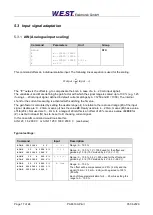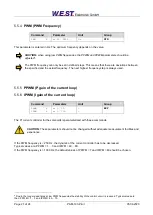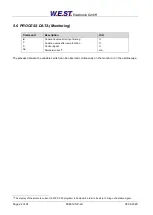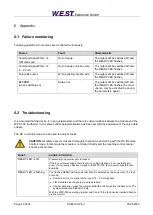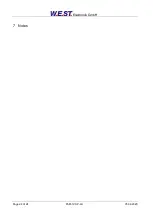
Page 20 of 24
PAM-190-P-A/I
5.4.4
POL (Output polarity)
Command
Parameter
Unit
Group
POL
X
x=
+ | -
-
EXP
This command allows a switch over of the output signal direction (after the MIN-MAX function).
Example:
POL:A
+
Input signal 0… 100 %, nominal output current 0… 100 %.
POL:A
-
Input signal 0… 100 % nominal output current 100… 0 %.
5.5 Output signal adaptation
5.5.1
CURRENT (Rated current range)
Command
Parameters
Unit
Group
CURRENT
X
x= 0|1
-
STD
The nominal current range is set with this parameter. Dither and also MIN/MAX always refer to the selected
current range.
0 = 1.0 A range
1 = 2.5 A range.
5.5.2
DFREQ (Dither frequency)
5.5.3
DAMPL (Dither amplitude)
Command
Parameters
Unit
Group
DFREQ
X
DAMPL
X
x= 60… 400
x= 0… 3000
Hz
0,01 %
EXP
The dither
3
can be defined freely with this command. Different amplitudes or frequencies may be required de-
pending on the respective valve. The dither amplitude is defined in % of the nominal current (see: CURRENT
command).
CAUTION: The PPWM and IPWM parameters influence the effect of the dither setting. These param-
eters should not be changed again after the dither has been optimized.
CAUTION: If the PWM frequency is less than 500 Hz, the dither amplitude should be set to zero.
3
The DITHER is a superimposed signal to reduce the hysteresis. This function is defined by the amplitude and frequency.
The DITHER frequency should not be confused with the PWM frequency. In some proportional valve documentations a
mistake is done by the definition of the DITHER / PWM frequency. It is recognizable by missing information about the
DITHER amplitude.












